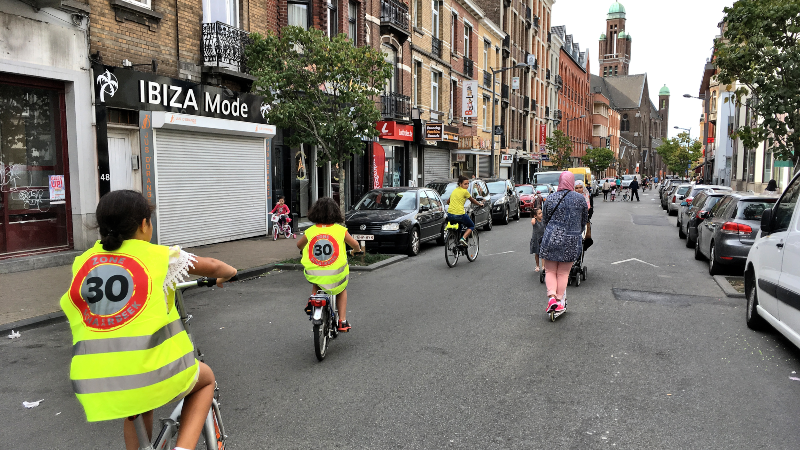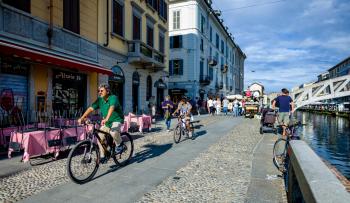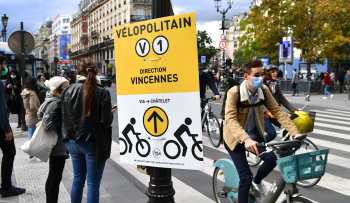
New studies, new plan: Brussels aims even higher after cycling grows by 20% and road fatalities decrease
New studies into cycling traffic and road safety in the Brussels-Capital Region provide remarkable insights two years into the cycling boom, while the city launches new plans to create a larger low-traffic zone in the Brussels city centre by August 2022.
One year after the implementation of the 30 km/h speed limit across the city of Brussels, various positive reports have shown a 50% reduction in road fatalities, simultaneous increases in the number of cycling journeys being taken and a solid preference for public transport as a primary mode of commuting.
With further road reforms due to come into effect from August 2022 that will see the introduction of a larger low-traffic zone within the Brussels “Pentagon” centre, these positive trends are likely to continue growing.
The number of people cycling in Brussels continues to grow
Cycling as a method of daily transport is continuing to grow in popularity, according to data from Acerta, an HR services company that investigated the mobility habits of 330,000 workers across Belgium and 14,700 from the Brussels-Capital Region. Of those surveyed, 14.57% stated that they primarily rode their bike to work all or some of the time, and a staggering 45.6% of workers in the capital stated that public transport was their primary mode of transport for commuting.

Number of cycle journeys in the month of January 2022. Graphic courtesy of Brussels Bike count.
A separate study, utilising primary data from Brussels Mobility’s cycle counters dotted around the city, showed continued growth of 20% even after the cycling boom year of 2020, which itself witnessed an unparalleled 64% increase. One counter, situated along the Molenbeek canal cycle path, actually broke the 1 million journeys barrier in December 2021, a first for the Belgian capital. Other areas that have benefitted from newly made-permanent cycling infrastructure also witnessed substantial growth in journey numbers, such as Rue de la Loi, which now has a bidirectional cycle lane.

Families enjoying quieter streets during a car-free day in 2019.
30 km/h speed limits have led to safer public spaces
Crucially, road safety data gathered by Brussels Mobility has recorded a 50% decrease in road fatalities when compared to 2020, one year on from the 30 km/h speed limit norm being established across the capital. Fatalities dropped from 11 to 5, whilst seriously injured road victims also dropped from 121 in 2020 to 100 in 2021.
Camille Thiry, spokesperson for Brussels Mobility called the reductions “a very positive development,” but Brussels Mobility Minister Elke Van den Brandt reiterated that the “objective remains zero deaths and zero serious injuries in Brussels.”
Perhaps surprisingly, Brussels Mobility data (drawn from all times of the day) also showed that despite the slower speed limit, there was no significant impact on overall journey times. Curiously, the number of vehicles speeding also fell over the course of 2021 with vehicles violating the 30 km/h speed zones 2.4% less than in 2020.
Also contributing to the city’s increased liveability are the drastic reductions in noise pollution levels being recorded since the introduction of the 30 km/h speed limit norm. Data varied enormously depending on the location, type of traffic and road surface, but in some places there was a drop of up to 4.8 dB (A).
“Road traffic is the number one source of noise in the capital, noise pollution is also the second environmental cause of morbidity, after air quality,” stated Marie Poupé, noise expert at Brussels-Environment. “Excessive exposure to noise can cause hearing problems, insomnia, learning and concentration difficulties, and can increase cardiovascular risks. City 30 is an important lever to improve the situation.”

The simplified version of the new circulation plan for the Pentagon, with main axes in blue. Graphic courtesy of GoodMove/City of Brussels.
New plans to enable a more liveable Brussels city centre
Building on these results, the City of Brussels also announced plans in February for the establishment of a larger low-traffic area within the “Pentagon” city centre on 16 August to improve the quality of life of inhabitants and the general atmosphere of the capital for tourists and visitors.
The announcement comes after widespread approval of the pedestrianised Boulevard Anspaach and a broad political spectrum of city councillors contributing to the new plan, with Green politician Bart Dhondt remarking that “this is not a plan of the Greens but of the majority. We are convinced that it will make the Pentagon more liveable.”
Of the growing population of inhabitants residing in the city centre itself, only 30% of families own a car and a clear majority of visiting shoppers (79%) go about their business without a car as the area has become hyper-accessible by public transport in recent years. The new plan has been drawn up after extensive public consultations and will be evaluated again after implementation in October 2024 prior to the municipal elections.
The announcement follows similar recently published plans for the communes of Schaerbeek and Anderlecht, all of which form part of the Good Move Regional Mobility Plan for the Brussels-Capital Region. The plans draw in part on the successful traffic reduction measures implemented in the nearby city of Leuven in 2017. The Flemish university city is seen by many as an example of best practice when designing policy to reduce congestion and make city centres more liveable.
The bigger picture: in Belgium, cars still dominate
Unfortunately, not all of the data compiled in these studies were positive. Indeed, the positive numbers related to cycling and public transport use presented by Acerta showed that Brussels-Capital Region is an anomaly in comparison to Belgium as a whole. Nationally only 7.8% of Belgian workers rely upon public transportation and 78.4% drive a car to work, with 19.5% using a company car for their daily commute.
Company car usage actually rose from 18% in 2020, and Niko Smeets of Acerta blames this rise on a competitive labour market in which tax incentives on company cars provides employers an easy bonus with which to attract and retain employees. However, “if hybrid working, ie a combination of office work and working from home, is also maintained after the coronavirus and workers reduce their number of commute kilometres yet further, it’ll be a win-win situation.”
On average, Belgians live 20 km from their place of work, whilst in Brussels-Capital Region that falls to just 14.7 km. Nevertheless, overreliance upon private motor vehicles is wholly unsustainable from an environmental and public health perspective.
Alongside the provision of safe and effective cycling infrastructure, cycling-enabling tax incentives that are equivalent to those currently used to provide company cars should be created, so that employees wanting to engage in more daily active travel have the opportunity to choose a new bicycle, e-bike or cargo bike with which to reduce the number of kilometres they drive when commuting.
Regions:
News category:
Contact the author
Recent news!
Upcoming events
Contact Us
Avenue des Arts, 7-8
Postal address: Rue de la Charité, 22
1210 Brussels, Belgium









